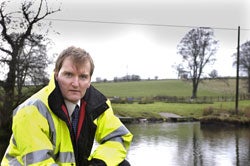| Electricity poses a potential danger to every one of us, but certain groups are more susceptible to the dangers, usually because of the environments in which they live work or spend their leisure time. Anglers are one of the most vulnerable groups as overhead electricity cables may be found near to fishing waters and because fishing equipment such as carbon fibre rods and poles make excellent conductors. All electricity companies take precautions to help ensure the publics safety; ground-mounted equipment is surrounded by enclosures and warning signs are posted on the equipment and fences. In addition, overhead cables are installed at a height normally not accessible to the public. However, manufacturers now routinely market carbon fibre poles that are in excess of 10m. These are extremely popular with anglers, but because of their size, create the opportunity for direct contact with overhead cables. Consequently accidents still occur due to a lack of awareness of the dangers involved with electricity.
“In order to minimise risk to the general public, we ensure that all uninsulated overhead cables are erected at a minimum height of 5.2 metres. However, the equipment and actions used whilst fishing increase the risk of coming into close proximity or even touching overhead lines. “All anglers need be aware of the dangers involved when fishing near electricity lines in order to minimise the risk of accidents. Whilst it is commonly understood that when casting a fishing line, direct contact between the rod or line and the cable will enable the transmission of electricity, it is not widely known that electricity may jump across air to lines when casting. Unfortunately this can be fatal.” According to Steve, the good news is that in comparison with other types of accidents, the figures for electricity related injuries and fatalities are low, which means many people are taking heed of warnings and implementing precautions against the dangers. But the tragedy is the accidents that have occurred that could have probably been avoided. “I can’t emphasise enough how important it is to look out for overhead lines before even approaching the fishing area. Lines can cross over access routes to fishing pools or car parks so it is essential that rods are carried horizontal to the ground. It is not always easy to estimate heights and distances of overhead lines, which is why we advise that you should fish at least 30 metres away from all power lines. Any individuals or angling clubs who would like to know more about the dangers surrounding fishing can obtain informative leaflets from Aquila Networks. “For instance, we have been involved with a Look Out! Look Up! Campaign in partnership with the Electricity Association, landowners, angling groups and tackle manufacturers. We have leaflets that give practical guidance on how the angling community can avoid such danger and we urge individuals and clubs alike to take advantage of these leaflets and display wherever they can. A cross industry forum is also developing information for landowners and developers.” Rodney Coldron from the National Federation of Anglers speaks about another way in which we can reduce the risks. He says, “One problem we have is the location of fishing pools that are being dug out by farmers or other land owners as a business venture. “It is often not intentional, but they are not taking into consideration the highlighted dangers of overhead electricity lines and as a result are being shut down by enforcing authorities. Our priority is the safety of anglers and so we advise land-owners to get the area checked out by their local Health and Safety office or Environmental Health Department. Their site must be a safe place to fish as we all want to enjoy countryside pursuits and activities without any injury or loss of life.” Other guidance is also available from the Health and Safety Executive (HSE) in the form of videos, books and leaflets. There are seminars and events staged throughout the country to help educate people about the dangers of electricity and Aquila can provide signs for most electricity danger warnings. But Steve says that the best way to protect yourself is to simply think about what you are doing before you do it. “By working together we’ll be able to reduce the number of needless accidents and fatalities related to electricity,” says Steve. HOW TO ACT SAFELY
|
Welcome!Log into your account











